
THE BATTLE IN THE AIR

Langenhoe
"IN THE SKY ABOVE US, LARKS NOW SOAR AND SING,
WHERE ONCE YOUNG MEN FOUGHT AND DIED."
This section is dedicated to the memory of those young men, who fought in the air over our villages and lost their lives. They came from many lands :-
Britain, Australia, Canada, New Zealand, Poland, Czechoslovakia, Norway, the United States, Germany and Italy amongst others. The enmity has gone, the sadness at their loss remains.
The first major event in the air over the villages was in the First World War. On Sunday 24th September, 1916 a Zeppelin came overhead between 0100 and 0200 hours. This was L33 and must have been a frightening sight being over 600 foot long and weighing 50 tons. She carried some 60 bombs and had been on a raid over London, where she had been damaged by gunfire. The Zeppelin seems to have been hit on her petrol tanks and on the bevel gearing of one of her wing propellers, which was shot off. She was seen at several points along the coast travelling low down and in evident difficulties. Trying to elude the pursuing aircraft she tried to steer over the sea. She went some 2 miles out to sea, before realising that she would not make it. She returned to shore, coming in very low. When she crashed, she just missed a wooden cottage. The crash site was on our neighbours at Wigborough, where she straddled the lane near New Hall Farm. The German Captain went to the local cottages to warn the people of the danger of fire. The crew then set fire to the crashed Zeppelin and surrendered to Special Constable Edgar Nichols. Ultimately the 2 Officers and 20 men were taken into custody by soldiers from Mersea Island and marched to Colchester.

+ + + + + + + + + + + + + + + + + + + + + + + + + + + + + + + + +
During the Battle of Britain and the attacks on the East Coast shipping, the battle raged in the sky overhead. The parishes were only 70 miles from German airfields in Occupied Holland. As a result, there were several planes, both Allied and German, brought down in the village, and in the Pyefleet Channel, that separates us from our neighbours on Mersea Island. Sadly not all the crews were saved. The following are the stories of the air war, as it affected the villages and just some of those, who died on our doorstep:-
24th August 1940
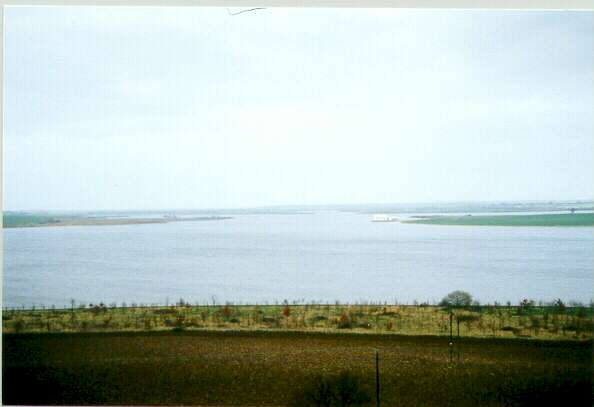
Abberton Reservoir as seen from the tower of Saint Andrew's
A Heinkel He 111, Al+/R, of 9/KG53 left from Lille in France at 1500 hours and joined a force of bombers attacking Hornchurch Aerodrome. The plane dropped 16 x 50 kilo bombs at Hornchurch and was caught over Abberton on the return flight by 2 RAF planes, which shot into and stopped the left engine. Sergeant W. Dymond of 111 Squadron had hit the engine. The Heinkel flew around on one engine and tried to make cloud cover. However, the second plane, a Defiant of 264 Squadron flown by Pilot Officer M. H. Young and Sergeant L. P. Russell delivered a second attack, which set fire to and completely riddled the aircraft -the pilot estimated 600 strikes. The three men in the rear of the aircraft were all wounded. The observer went back to attend to them but did not return. All the controls were damaged and the pilot and observer baled out. The aircraft crashed on the far side of the reservoir and three bodies were recovered from the wreckage. The observer was posted as "missing" and subsequently as "Killed in Action". His parachute was found near the crashed plane but he fell into the reservoir and drowned. His body has not been recovered.
The three recovered from the plane were buried in the Military plot at Colchester Cemetery on the 30th August. They were :-
Unteroffizier Alfred Kramer, Feldwebel Enrich Salomo and Erwin Gleissner.
At the same, time another 4 German airmen, who had been killed near Colchester on the 26th August were buried in the same ceremony. They were Unteroffizier Herbert Heinrich and Oberfeldwebel Kurt Rosler at Great Tey: and at Great Bentley, Unteroffizier Paul Nick & Feldwebel Werner Opper
The service was performed at the graveside, by the Reverend W. J. Heaton M.A. (Chaplin to His Majesty's Forces) (reference 2). Post war, these 7, along with many other German casualties were transferred from our local churchyards and cemeteries to the Cannock Chase German War Cemetery in Staffordshire.
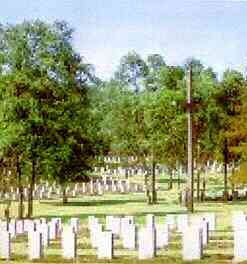
The German Cemetery at Cannock Chase in Staffordshire
The crew of the Heinkel 111 brought down at Abberton were :-
Alfred Kramer was born 14th April 1917. He is buried at Block 5 row 7 grave 163 at Cannock Chase.
Erich Salomo was born 30th June 1920. He is buried Block 9, row 5, grave 27.
While Erwin Gleissner was born 8th July 1916 is buried in Block 5, row, grave 164.
Their observer was Major de Reserve Karl Waldemar Ritscherle, 69041/19. His name is commemorated at Cannock Chase. His body was recovered and was found in the same grave at Colchester Cemetery as Erich Salomo, when they moved the bodies to Cannock Chase in 1963. Karl was born 1st May 1898 in Karlsruhe, Baden and was a war hero from the First World War. He joined as a sixteen year old on the 5th September 1914 and served on the Eastern Front for 2 years with the 1 Badisches Lieb- Dragoner- Regiment Nr.20. Karl was awarded the Iron Cross 2nd Class on the 6th September 1916. He subsequently became an aerial gunner with Schutzstaffel 8 on 16th April 1917. He won the Iron Cross 1st Class on the 15th November and on the 8th December was awarded Baden's Silver Verdienst-Medaille. Karl was commissioned on 27th December and became a pilot on 22nd June 1918. He flew Fokker DV11s with the Royal Prussian Jagdstaffel 60, where he had a further 4 planes and an Observation Balloon added to his list of victories. Overall he is listed with 8 victories. On the 18th September 1918, Karl was awarded the Knight's Cross with Swords of the Order of the Zahringer Lion from Baden. Karl was not a member of the official crew of the Heinkel 111 but was flying as a passenger on the raid on which he died in 1940.
31st August 1940
Early in the morning of the 31st August, 56 Squadron were scrambled at North Weald to meet an incoming German force of 200 enemy aircraft. They clashed over our area. It turned out to be a bad day for 56 Squadron and they only claimed 1 Messerschmitt Bf109. At 0845 Hurricane, V7378, flown by
Flight Lieutenant Percy Stevenson WEAVER DFC
was involved in a dog fight with a Messerschmitt Bf 109 and was shot down. He crashed into the nearby River Blackwater near Osea Island. Sadly he did not survive the crash and his body was not recovered. One other pilot from 56 Squadron had to bale out, while two others were wounded and crash landed. (reference 6)
Percy was aged 25 and the son of Ernest and Catherine WEAVER of Chippenham, Wiltshire. He was nicknamed "Squeak" from his initials PSW, which tallied with a famous cartoon series "Pip, Squeak & Wilfred". Percy was a pre-war pilot and had joined Blue section of 56 Squadron on the 5th June following their arrival at North Weald from France. Between the 20th July and his death on the 31st August, he had shot down nine enemy aircraft. He himself had previously been shot down by return fire on the 28th August, three days before his death.
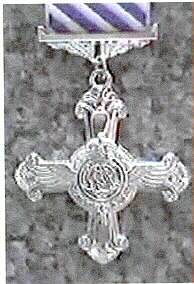
Percy had been recommended for a DFC prior to his death and it was awarded posthumously on the 1st October 1940. He is commemorated on the Runnymede Memorial in Surrey on Panel 5.
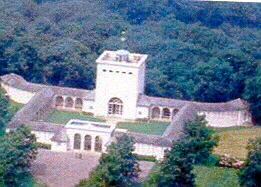
3rd September 1940
A series of dog fights occurred during the day.
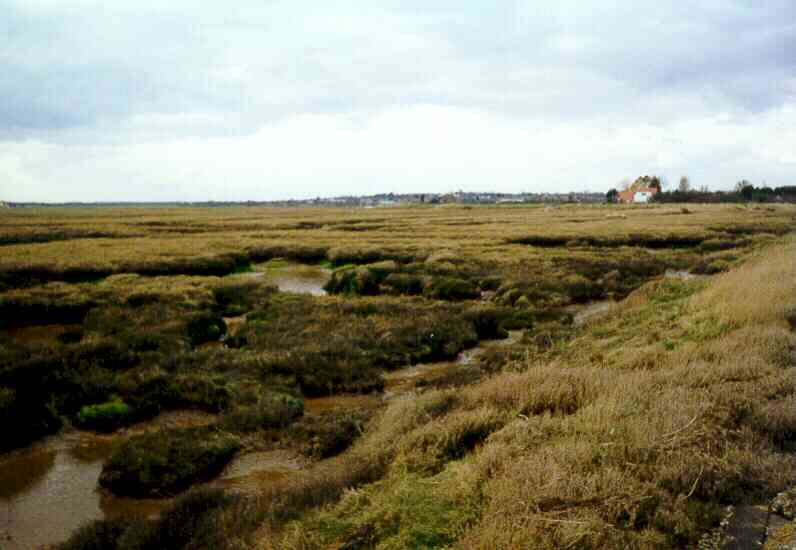
The Essex marshes at Pyefleet , Langenhoe
During a bombing raid on North Weald airfield on Tuesday, the 3rd September 1940, a Dornier DO17, U5+AN, (Werke No 3450) 5/KG2 crashed in the Pyefleet Channel . It had jettisoned its bombs and then been caught by Green Section of 17 Squadron RAF. 17 Squadron, who had just moved back to the nearby Debden airfield the previous day, the 2nd September, were "scrambled" at 0930 to meet the incoming bombers. The Hurricanes, which shot the Dornier down, were flown by Pilot Officer H. A. C. Bird-Wilson, Pilot Officer J. K. Ross, and Sergeant D.A. Sewell (reference 1). Of the Dornier's crew of 4, only Feldwebel Kreigl, who baled out was saved. He was rescued by one of the Brightlingsea based launches ( reference 3). The others, who died in the wreck were:-
Leutnant Heinz GŁnter SCHILDT,
Heinz was born in Berlin on the 1st May 1917
Unteroffizier E. SWINDEK
Gefreiter P. NIEGISCH
It is believed their bodies lie buried close to where they crashed. The crater is still visible on the Military Ranges, close to Langenhoe Hall, which is the site of a battle fought a thousand years ago between Saxon and Dane.

The crater where the Dornier landed
Another Hurricane, P3539(also listed as P3637elsewhere), belonging to 17 Squadron was involved in the same melee with the Germans. This plane was flown by
Flight Officer David Harry Wellsted HANSON.
He was himself shot down having just shot down a Dornier (reference 5) but managed to bale out. People in the village at the time, believed it was the Dornier that crashed in Langenhoe that he had hit. Unfortunately, David was only at 100 feet by the time he climbed out and died on impact. The plane crashed farther south on Foulness Island.
David was 22 years old and the son of Colonel Harry Hanson DSO, TD, and Ivy Hanson of Rolston Hornsea. He had attended Bramcoat Preparatory School and Winchester College. He is buried at Mappleton (All Saints) Churchyard in Yorkshire.
The three crew members of the Dornier, who crashed at Langenhoe were not amongst the number of Germans buried at Cannock Chase. Subsequent, excavations of the site have revealed artefacts such as parachutes, boots and life jackets, which suggest that they died in the crash but no sign of their bodies. It is probable that their bodies could not be recovered due to the swampy nature of the area at that time. Thus they must be considered lying at rest close by in unrecorded graves.
They have therefore been adopted by Saint Andrew's Church Memorial Book and website, along with those, who died on the 24th August 1940 at the Reservoir.
29th October 1940
A German Messerschmitt 109, belonging to 11/LG2, was shot down in flames into the river Blackwater close to our neighbours Peldon. The identity of the pilot and his fate are not known. The plane had been shot down by either Sergeant Stroud or Pilot Officer Millington of 111 Squadron RAF. Almost simultaneously, another ME 109 of 4/LG2, coded 3X+N Werke number 5593, was shot down by a Polish Pilot, Michal Maciejowski, also of 111 Squadron RAF.
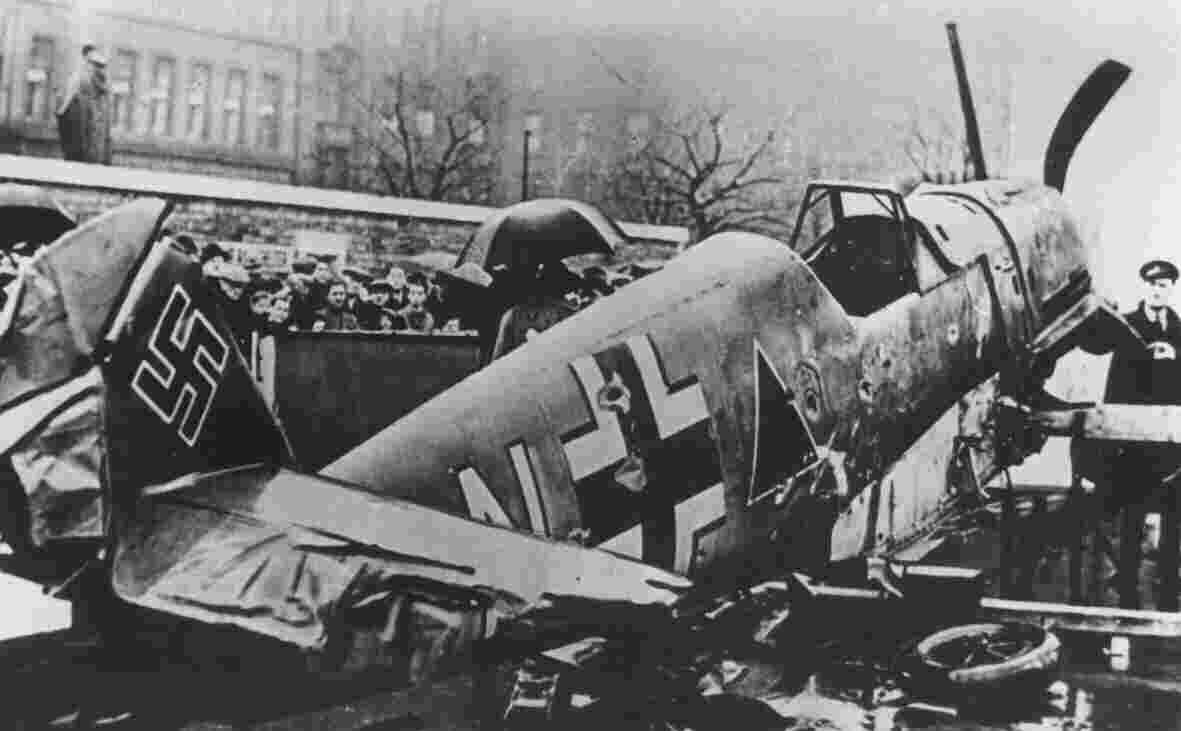
Harmerling's plane on show
The German pilot, Oberfeldwebel Josef Harmeling managed to land in the fields around Wick Farm , Langenhoe. He was wounded and survived to become a POW ( reference 4). Apparently he was captured by the local gamekeeper, Jum (short for Jumbo) Brown, who was a private in the Essex Home Guard. He took his rifle and rushed over 2 fields to the plane, where he called on Harmeling to surrender. Fortunately for Harmeling he did ,as Jum was a crack shot. Jum prevented him from setting fire to the plane and as a result a complete plane with all its ammunition fell into British hands. Jum took Harmeling home for breakfast. When he had finished his breakfast, Jum marched him across to the local Regular Army detachment. Jum said that when Harmeling crashed, the British plane followed him down to see that he landed alright and that the 2 pilots waved to each other. Jum was awarded a Certificate by the Home Guard in recognition of his bravery in single handed sorting out the capture of plane and pilot.
The following is a translation of a letter (*) by Josef Harmeling describing his ordeal :-
Here is an account of my sortie on 29th October 1940, on which date I became a prisoner of war in England.
It was late in the afternoon, about 1700 hours (local time) when about 40 Messerschmitts Bf 109's of my Gruppe took off from Calais/Marck airfield. We headed on a course for London and reached the English coast at about 6,000 metres.
Our Gruppe's objective was an airfield to the north-east of London (North Weald). This was a diversionary feint attack about 20 kilometres from the primary target and we took the opportunity to descend to about 4-500 metres for the attack.
It was at this altitude that we struck at the target with bombs and our fixed armament and it was during this low-level attack that I received a hit in the radiator system, presumably from the ground defences. The result was that the coolant temperature rose quickly and the motor commenced losing revs. with alarming speed. However, I sought to gain height, in case I had to get out in an emergency.
Soon after this two British fighters, a Spitfire and a Hurricane attacked me and I was unfortunately wounded in the head and right arm whilst at an altitude of about 80 metres.
Eye witnesses later reported that my machine burned where it came to rest in a rural area near Colchester. After my (pancake) landing I summoned my strength to jump out of my aircraft and attempt to destroy it but some British soldiers intervened. By now I had recovered and took the opportunity to thank those who helped me. They were, to me, safety- although enemies, those who first gave me aid.
The Doctor who removed a fragment of metal from my person also treated me in an exemplary manner... signed Josef Harmeling
Jum also had another plane nearly hit his home. This was a Wellington bomber that crash landed in a nearby hedge. The bomber was piloted by a member of the Wills tobacco family. Jum provided First Aid to the pilot. Having called the police and an ambulance, he then tended to the other members of the crew.
15 April 1943
A mosquito fighter from 157 Squadron based at Bradwell, just across the river Blackwater shot down a Dornier 217. The mosquito was piloted by Flight Lieutenant Benson and his navigator was Lewis Brandon. The Dornier code F8+EN of KG40, crashed nearby at Layer Breton. The crew were :- Unteroffizier Walter Schmurr (wounded), Unteroffizier Artur Schwarz (POW), Lt. Heinz Hertram (POW) and Unteroffizier Frank Witte killed.
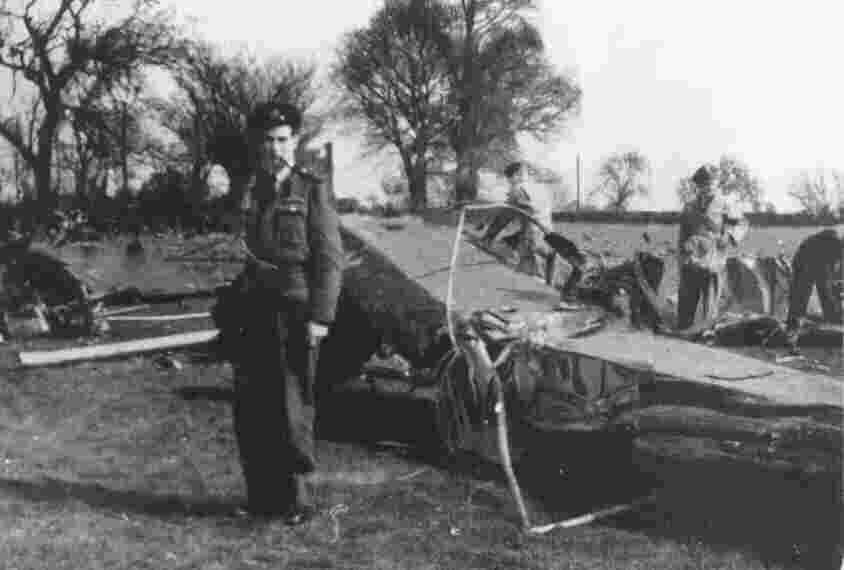
Flight Lieutenant Benson with the crashed Dornier
The is a story, which as yet has not been verified that the crew of another German aircraft had ay lucky escape. It is meant to have crashed late in the war into Abberton Reservoir. They managed to escape the sinking craft and reach the shore in a dinghy, where they were captured. They were particularly lucky, as the reservoir had been mined, as an anti-invasion precaution to prevent it being used by German seaplanes.

Abberton Reservoir was also used for practice by number 617 Squadron RAF, the "Dam Buster Squadron", in preparation for the raids on the Ruhr Dams. The final rehearsal took place on Abberton Reservoir on the night of 14th May 1943. Two nights later they left their base in Scampton, Lincolnshire, to attack the damns at Eder and Mohne. Although the raid was successful in breaching a dam, the cost was heavy. Eight of the Avro Lancasters failed to return of the 19 bombers sent. 53 of the 133 crew members were lost.

In October 1995, Langenhoe Primary School moved to new buildings the other side of the road in Abberton. One of the features of the new buildings is a set of wooden sculptures in the play area. One of these depicts a German airman. There is an unsubstantiated story that during the Second World War, a German was captured while hiding in the old school and this is the basis for the statue. However, even though the story may not be true, the statue does provide a reminder to both us and our children of the times, when young men fought and died in the sky overhead.
ReferencesDetails on the Dornier crash on the 3rd September 1940 were obtained from a number of sources:- Air Historical Branch, MOD. The website of the "East Anglian Aircraft Research Group" (reference 1), the CWGC, the book "The Battle of the East Coast (1939-45)" by J. P. Foynes ( reference 3).
Details of the Heinkel crash on the 24th August 1940 are supplied by the MOD from Intelligence reports compiled at the time. Information on Karl Ritscherle came also from the CWGC, the books "Above the Lines" by Franks, Bailey & Guest, Grub Street Publications ISBN0-948817-73-9 & "The Jasta Pilots" by Franks, Bailey & Duiven by the same publishers ISBN 1-898697. See http://209.235.66.44/WW1/Germans/Jastas/Jasta_60.htm & http://209.235.66.44/WW1/Germans/Pilots/Ritscherle.htm
Note the book "Air Raid, The Enemy Air Offensive against East Anglia 1`939-45" by M. J. F. Bowyer credits Flight Officer Hanson with shooting down U5+AN.
Details on the British casualties and the picture of the Runnymede Memorial are kindly provided by the Commonwealth War Graves Commission.
(Reference 2) The Colchester Gazette dated 4th September 1940. Though it refers to 7 unnamed German Airmen. The names are taken from the Colchester Cemetery Records. Note Ehsmann is erroneously shown as dying on the 3rd September 1940 in the Cannock Chase Records, as he was interred in Colchester on the 30th August.
(Reference 4) is taken from http://www.battleofbritainpress.co.uk/few/Few/maciejowski.html , which tells the remarkable story of this pilot, who ultimately settled in Canada. Also (Reference 5) Information on F/O Hanson is taken from other sections of this website .
(Reference 6) Details on F/Lt Weaver are on a number of sites including the above (reference 4) & www.pnc.com.au/~insight/heavens/heavens-008.html + www.tne.net.au/njh/Airpower/56SQN.html .There is a beautiful picture of Blue Section of 56 Squadron on the 20th July. This includes F/Lt Percy Weaver DFC and is on www.eagle-editions.com/britain.htm
The picture of Zeppelin, L33, is from the book "The Great War" volume 8, plus some of the details. The balance of information is from local sources.
(*) We are indebted to Mr Derek Webb for kindly providing the pictures of the Messerschmitt, the Dornier's crater, the letter from Josef Harmeling & the photo of the 2nd Dornier at Layer Breton.
last updated Thursday, December 05, 2002
**********************************************************
These pages are dedicated to the memory of the Fallen from the two World Wars, who lived in Abberton & Langenhoe.. Prepared by Saint Andrew's Parochial Church Council. November 11th 2000